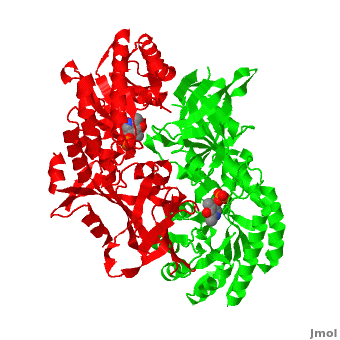CRYSTAL STRUCTURE ORNITHINE DECARBOXYLASE FROM MOUSE, TRUNCATED 37 RESIDUES FROM THE C-TERMINUS, TO 1.6 ANGSTROM RESOLUTION (7odc) [1][2]
Although, 7odc is a 1 chain structure, the biological relevant molecule for 7odc can be assembled from the contents of the deposited coordinates by the application of crystallographic symmetry operations to give a dimer. It can be downloaded. A sequence alignment and structural comparison of mouse ornithine decarboxylase (mODC) to mouse Antizyme Inhibitor (AzI, 3btn) show high sequence identity (~50%) and structural similarity between mODC and AzI monomers (RMSD value is 1.6 Å). The of mODC (red and green) to mouse AzI crystallographic dimer (mAzI, cyan and blueviolet) is shown. Superposition of the of mAzI and mODC showing the inter-subunit variable loops (AzI residues 355–362 and 387–401). AzI loops are in black, and ODC loops are in yellow.
The two AzI monomers (cyan, blueviolet) have only (< 3.5 Å apart), while there are more contacts (83) between the two monomers of (red, green. Moreover, the surface area buried by the two mODC monomers is significantly larger than the one buried by the AzI monomers. These features explain a very weak crystallographic AzI dimer.
The zipper, formed by conserved hydrophobic residues in mODC, stabilizes its dimeric structure. These residues involve F397(B), Y323(B), Y331(A), Y331(B), Y323(A), and F397(A) (the names of the chains are in brackets). The residue Y331 in the is substituted by S329 in AzI and interferes with the formation of a similar zipper in AzI. Hence, in this hydrophobic zipper is absent. Many residues, participating in the ODC interdimer interface interactions, are conserved among the ODCs from variuos organisms, but in AzI these residues are not conserved. Furthermore, the AzI conserved residues do not participate in interdimer interactions. For example, mODC possesses (K169–D364 and D134–K294) stabilizing the ODC homodimer. In AzI, these 4 corresponding residues (, respectively) are also present, but are too far apart to form a salt bridge. The two AzI monomers are positioned farther apart, in comparison ot ODC monomers, preventing the formation of interdimer interactions.
Docking and molecular dynamics studies of peptide inhibitors of : a rate-limiting enzyme for the metabolism of Fusarium solani [3]
Fusarium solani causes stem and fruit rot disease in Capsicum sp. causing severe losses. Use of peptides as antimicrobials has been reported earlier. The peptide designing for a specific fungus using its own protein (enzyme) may be a useful strategy for the control of disease. Polyamine biosynthesis is responsible for growth of Fusarium solani. The rate-limiting step of this process is decarboxylation of ornithine. Ornithine decarboxylase (ODC) (EC 4.1.1.17) is an enzyme that catalyzes the decarboxylation of ornithine to putrescine. is an amino acid, whereas is a polyamine. Inhibitors of having higher binding capacity than ornithine can be used for treating the plant from fungal disease.
In this study, we designed 15 peptide inhibitors by the random alteration of active site residues at which ornithine binds. These inhibitors were peptides of the length of nine residues. The peptide, (peptide GLIWGNGPF is colored in orange) and residues of ODC active site are colored in darkmagenta, which is four times greater than ornithine. Thus, peptides can be used as a potential inhibitor to block the pathway responsible for the growth of the pathogen.

